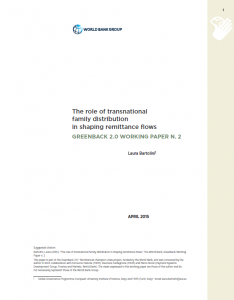
Migration experiences are often associated with some sort of transnational economic activity which connects the past and the present of migrants abroad, and specifically with remittances. Motivations to send money at origin have been deeply investigated at the micro as well as at the macro level, as remittances can affect recipient households’ wellbeing, investment and consumption levels in the receiving countries and play an insurance role against external shocks.
This paper contributes to the literature on migrants’ remittances providing evidence for migrants from Morocco, Peru and Romania, three traditional labor-exporting countries with a medium level of economic development, from three different geographical areas and with different migration patterns to Italy. Exploiting a relatively rich, albeit small-scale, dataset we analyze the spatial distribution of migrants’ nuclear families and households and we build three different migratory profiles – Loners, Pioneers and Followers – characterized by the timing and sequence of the migration event with respect to the rest of the nuclear family. Then we test a negative binomial model to describe the variation in the variable “remittances amount”. Beyond cross-country variations and after controlling for the most commonly used individual demographic and economic characteristics, our analysis consistently clusters migrants according to their family and household structure in Italy and abroad to explain the total amount of remittances sent to the origin country.
